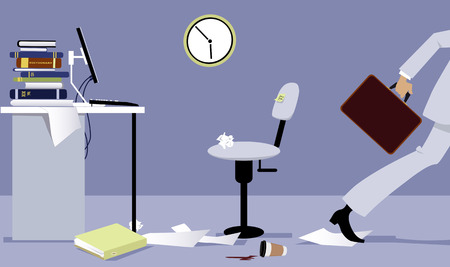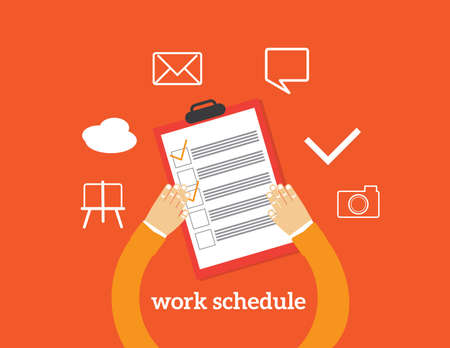Why Timely Follow-Up Matters
After a job interview, what you do next can make a big difference in how employers see you. Responding quickly and professionally shows that you are interested, respectful, and serious about the opportunity. Let’s take a closer look at why timely follow-up matters so much and how it shapes your relationship with potential employers.
The Power of Prompt Communication
Sending a thank-you email or message within 24 hours is now expected in most American workplaces. This prompt response highlights your enthusiasm and attention to detail. Employers often have to choose between many qualified candidates, so a quick follow-up can help keep you top of mind.
Impact on Candidate Perception
| Action | How It’s Perceived by Employers |
|---|---|
| Prompt follow-up (within 24 hours) | Shows professionalism, strong interest, and reliability |
| Delayed follow-up (after several days) | Might be seen as lack of interest or poor communication skills |
| No follow-up | Often interpreted as disinterest or lack of etiquette |
Building Positive Rapport with Employers
A timely follow-up is not just about saying “thank you.” It opens the door for continued communication and helps build a positive relationship with hiring managers. This extra effort can set you apart from other candidates who may not follow up at all. When you show respect for the employer’s time and process, it reflects well on your work ethic and personality.
Key Takeaways for Job Seekers
- A prompt thank-you note demonstrates genuine interest and professionalism.
- Timely communication helps establish trust and keeps you memorable to employers.
- Building good rapport early on can influence future interactions throughout the hiring process.
2. Recommended Timing and Methods for Follow-Up
Best Practices for When to Follow Up
After a job interview, following up at the right time is key in the American job market. Acting too quickly can seem pushy, while waiting too long may make you appear uninterested. Here’s a simple timeline to guide your follow-up:
| Action | Recommended Timing |
|---|---|
| Send Thank-You Email | Within 24 hours after the interview |
| First Follow-Up (if no response) | About 1 week after your thank-you email |
| Second (and final) Follow-Up | 7-10 days after your first follow-up |
Email Etiquette for Follow-Ups
Email is the most common and preferred way to follow up in the U.S. Here are some tips for crafting a professional and polite follow-up email:
- Use a clear subject line: Example: “Thank You – [Your Name], [Position Title] Interview” or “Following Up on [Position Title] Interview”
- Keep it brief and polite: Express appreciation for the opportunity, briefly restate your interest, and ask about next steps.
- Proofread before sending: Make sure your message is free of errors and uses a respectful tone.
- Avoid being pushy: Don’t demand an answer or send multiple emails in a short period.
Sample Follow-Up Email Template
Hello [Interviewer’s Name],
I wanted to thank you again for meeting with me about the [Position Title] position last [day]. I enjoyed learning more about the team and am very excited about the opportunity to join [Company Name].
Please let me know if you need any additional information from me. I look forward to hearing about the next steps.
Sincerely,
[Your Name]
Appropriate Communication Channels in the U.S.
The standard method for following up after interviews is email. Phone calls are generally reserved for later stages or if you were specifically invited to call. Avoid texting unless you have been told otherwise by your contact at the company. Here’s a quick guide:
| Channel | When to Use It | Notes |
|---|---|---|
| Main follow-up method after interviews | Professional and expected in most industries | |
| Phone Call | If invited to do so or if instructed during interview process | Use sparingly; be concise and respectful of their time |
| LinkedIn Message | If you connected during interview process or haven’t received a response via email after several attempts | Keep message brief and professional; not always appropriate for every industry/company culture |
| Text Message | Only if interviewer gave explicit permission or initiated texts first | Avoid unless directed otherwise by company contact person |

3. Crafting a Professional Follow-Up Message
Sending a well-written follow-up message after a job interview is a key step in the hiring process. Not only does it show your appreciation for the opportunity, but it also reinforces your interest in the position and highlights your professionalism. Here’s how you can craft a concise, polite, and tailored follow-up that makes a positive impression.
Why Your Follow-Up Matters
A thoughtful follow-up can help you stand out from other candidates. It signals your enthusiasm, attention to detail, and strong communication skills—qualities highly valued by employers in the United States.
Essential Elements of a Great Follow-Up Message
| Element | Description |
|---|---|
| Subject Line | Clear and direct, e.g., “Thank You – [Your Name] Interview for [Position]” |
| Greeting | Address the interviewer by name (e.g., “Dear Ms. Johnson”) |
| Expression of Gratitude | Thank them for their time and the opportunity to interview |
| Personalization | Mention something specific discussed during the interview |
| Reaffirm Interest | Briefly restate your excitement about the role and company |
| Professional Closing | Close with “Sincerely,” “Best regards,” or similar, followed by your full name |
Sample Template for Reference
Below is a simple template you can adapt to your own style and situation:
Sample Follow-Up Email
Subject: Thank You – Jane Smith Interview for Marketing Coordinator
Dear Mr. Brown,
I wanted to thank you for meeting with me yesterday to discuss the Marketing Coordinator position at Acme Corp. I enjoyed learning more about your team’s creative projects and was especially interested in your approach to digital campaigns.
I am very enthusiastic about the opportunity to contribute my skills to Acme Corp and help drive successful results.
Please let me know if there’s any additional information I can provide.
Sincerely,
Jane Smith
Common Pitfalls to Avoid
- Avoid sending generic messages—always personalize!
- Don’t wait too long; send your message within 24-48 hours after the interview.
- Keep it concise—one or two short paragraphs are best.
A professional follow-up message reflects your respect for the interviewers time and demonstrates genuine interest in joining their team. By following these best practices, you’ll make a lasting impression that supports your candidacy.
4. Common Follow-Up Mistakes to Avoid
Why Mistakes Matter in Follow-Up
Following up after a job interview is important, but how you do it can make a big difference. Some common mistakes can hurt your chances of getting the job, even if your interview went well. Let’s look at what you should watch out for and why it matters.
Typical Follow-Up Pitfalls
| Mistake | What It Looks Like | Impact on Your Candidacy |
|---|---|---|
| Excessive Follow-Ups | Sending multiple emails or calls within a short time (e.g., every day) | Appears impatient or desperate; may annoy hiring managers |
| Overly Casual Language | Using slang, emojis, or informal phrases like “Hey” or “TTYL” | Comes across as unprofessional; may seem disrespectful to company culture |
| Lack of Personalization | Sending generic messages that could go to anyone (“Dear Sir/Madam, thanks for the interview”) | Makes you look uninterested or careless; misses a chance to stand out |
| No Proofreading | Emails with typos, grammar mistakes, or wrong company names | Sends a message that you lack attention to detail; may create doubts about your professionalism |
| Ignoring Timelines Given by Employer | Following up before the employer’s stated decision date or deadline | Shows you didn’t listen during the interview; seen as pushy or impatient |
How These Mistakes Affect You
If you make these common errors, it can change how hiring managers see you. Instead of remembering your skills and personality, they might focus on your impatience, lack of professionalism, or poor communication style. In a competitive job market in the U.S., even small missteps in your follow-up can tip the scales against you.
Avoiding Pitfalls: Keep It Professional and Thoughtful
The key takeaway is simple: be polite, professional, and personal when following up. Use clear language, show genuine interest in the role, and respect the employer’s timeline. By avoiding these common mistakes, you’ll leave a strong and positive impression after your interview.
5. Staying Patient and Respectful During the Waiting Period
Why Patience Matters After a Job Interview
After you’ve sent your thank-you note and followed up appropriately, it’s natural to feel anxious while waiting for feedback. However, staying patient and respectful is crucial in maintaining a positive impression with potential employers. Hiring decisions can take time, and how you handle this period reflects your professionalism.
Tips for Maintaining Professionalism While You Wait
| Tip | Why It’s Important |
|---|---|
| Limit Follow-Ups | One follow-up email after your thank-you note is usually enough unless the employer gave you a specific timeline. Too many emails can come across as pushy. |
| Stay Positive and Polite | If you do need to reach out again, keep your tone friendly and professional. Express gratitude for their time and reaffirm your interest in the position. |
| Continue Your Job Search | Don’t put all your eggs in one basket. Keep applying to other positions so you don’t feel stuck or overly anxious about one opportunity. |
| Avoid Negative Comments Online | Refrain from posting frustrations about the process on social media. Employers may see this, and it could hurt your chances. |
| Set Realistic Expectations | Understand that hiring processes can take several weeks, especially if multiple rounds of interviews are involved or internal approvals are needed. |
How to Manage Your Expectations
- Ask About Timelines: If not already discussed, it’s okay to politely ask during your interview when you might expect to hear back.
- Prepare for Any Outcome: Even if you feel confident, remind yourself that there are factors beyond your control.
- Avoid Constant Checking: Try not to check your email obsessively. Set specific times to review messages so you can stay focused on other activities.
- Use the Time Wisely: Learn new skills, research other companies, or network with professionals in your field while waiting.
Sample Follow-Up Timeline Table
| Action | Recommended Timing |
|---|---|
| Send Thank-You Note | Within 24 hours after the interview |
| First Follow-Up Email (if no response) | 7-10 days after interview or as indicated by interviewer’s timeline |
| Second (Final) Follow-Up (optional) | A week after first follow-up if no reply; then wait for a response or move on |
The Bottom Line: Don’t Jeopardize Your Standing
Your behavior during the waiting period can be just as important as how you performed during the interview. By showing patience, respect, and continued professionalism, you’ll leave a lasting positive impression—regardless of the outcome.


